Lost Soul: Richard Stanley vs Hollywood commerce
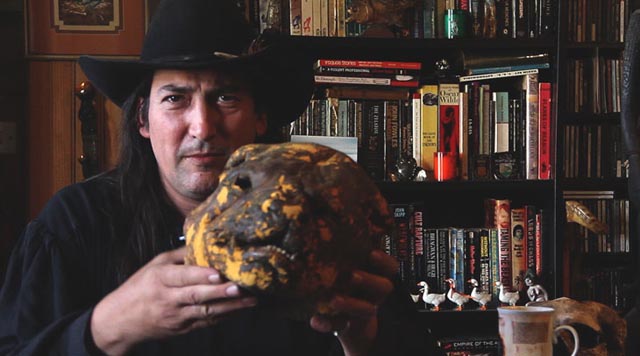
Context is important. When I first saw The Island of Dr. Moreau in 1996, I knew very little about the background of the production or the man who had originally initiated the project. I had seen Richard Stanley’s Hardware (1990) several years before, but it hadn’t made much of an impression; it seemed fairly derivative (Mad Max and The Terminator), was reasonably well-crafted, but not enough to make it stand out. (I have a higher opinion of it now after seeing it a few more times, but more particularly because I know more about Stanley himself now.) When Moreau was released, I wanted to see it for a number of reasons: it was based on a great novel which had been tackled by several filmmakers in preceding decades with varying results (Erle C. Kenton’s pre-code masterpiece Island of Lost Souls and Don Taylor’s dismal 1977 version, plus a couple of made-in-the-Philippines horror cheapies I had read about but, at that time, not yet seen); it had an interesting cast in Marlon Brando, Val Kilmer and, particularly, David Thewlis, who had been so impressive (and disturbing) in Mike Leigh’s Naked (1993); and it was directed by John Frankenheimer, a filmmaker of whose earlier work I was a big fan even though he hadn’t made an interesting theatrical feature in two decades (he had, however, done some good work for television in the intervening years, like The Burning Season and Andersonville, made immediately before Moreau).
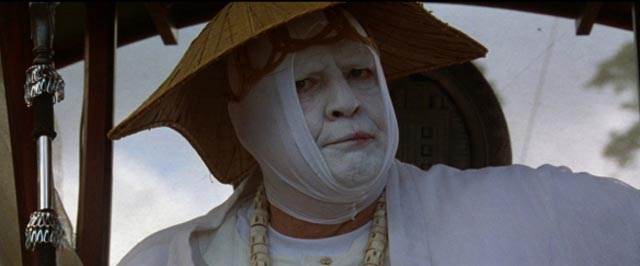
And so I went to the movie “fresh”, without any negative preconceptions. And I loved it. In fact, it remains a favourite today, even though I do now know about its troubled history and am fully aware of the utter contempt in which it’s held by almost everybody else as “one of the worst movies ever made”. That isn’t just a critical and audience opinion; it’s shared by many people who worked on it. Would I have responded differently at that first viewing if I’d known that the production was a chaotic disaster? Possibly. But not knowing that allowed me to see the movie itself as a self-contained entity. And what I saw was both entertaining and, it seemed to me, a sharp satire on the legacy of Margaret Thatcher. That assertion often gets me odd looks when I express it. And, given what I now know about the making of the film, I certainly can’t say that what I see was in any way intended by the people involved – and yet, I still see it.
Marlon Brando has been seriously mocked for his performance as Dr. Moreau, as he had previously been mocked for other eccentric performances, often attributed to his contempt for the material he was working with (his assassin in Arthur Penn’s underrated The Missouri Breaks [1976], for instance, or his Irish groundskeeper in Michael Winner’s The Nightcomers [1971]). He may well have taken to amusing himself by being deliberately outrageous, but he was also a very talented actor and that self-amusement resulted in bizarre yet coherent performances. The moment he shows up in the film in his “Pope-mobile”, wrapped in diaphanous white, his face a painted mask, his lips pursed and teeth protruding, and says his first lines in that peculiar accent, I saw and heard Margaret Thatcher, and that impression brought the film into focus and gave it life for me.
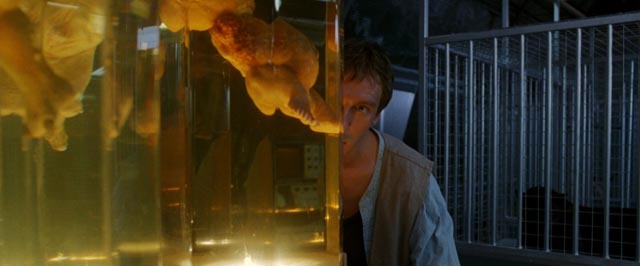
Here was a bitter portrait of the monstrously twisted social experiments of the Thatcher era in which the working class was seen as little more than beasts to be first crushed and then remolded into a parody of the conservative idea of a society which reflected the narrow views of its masters. (In fact, Thatcherism was to some degree the application of the colonialist attitudes of the 19th Century British Empire to the population of Britain as a whole.) This would make Val Kilmer’s Montgomery a version of John Major, a pathetic shadow of the Iron Lady straining to take over although devoid of any original ideas of his own; when he finally gets his chance, things collapse around him because he lacks the will of Moreau/Thatcher, let alone his/her overriding “vision” of a world re-made in his/her own image. Thewlis’ Edward Douglas is a rational Englishman who stands apart from the destructive social experiment and serves as a representative of those who powerlessly watched as Thatcher dismantled the nation and society (Thatcher famously said “there is no such thing as society”, meaning that – as in the United States’ myth of itself – all that exists is a bunch of independent self-interested units who owe nothing to each other).
H.G. Wells’ novel is about a rational scientist who sets out to prove not only that there is a continuity between the animal and the human (it’s a Darwinist parable), but that he himself has the power to create the human, to be in effect God. Likewise, Thatcher set out to transform what she saw as the shapeless mass of English society into a mirror image of her own egotistical self-interest. The consequences are still apparent today, but in the real world the victims of her experiment have never risen en masse to overthrow their Draconian rulers, as the animal people of The Island of Dr. Moreau finally do.
Even knowing what I now know about the background of the movie, I still see these things in it. Which, I guess, makes me just like the people in Rodney Ascher’s Room 237, who see what they see in Stanley Kubrick’s The Shining regardless of whether Kubrick intentionally placed those things in the film.
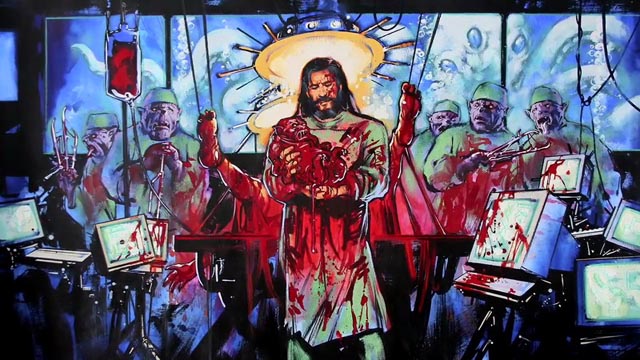
All of which produces a somewhat conflicted response to David Gregory’s fascinating documentary Lost Soul: The Doomed Journey of Richard Stanley’s Island of Dr. Moreau (2014). While the documentary itself is essentially just a talking-heads account of the production, the story it tells is one which ranks with Hearts of Darkness (1991, an account of the making of Apocalypse Now), Burden of Dreams (1982, the making of Fitzcarraldo) and Lost in La Mancha (2002, Terry Gilliam’s failed attempt to film Don Quixote). It also bears some resemblance to Frank Pavich’s Jodorowsky’s Dune.
Richard Stanley was still in his late twenties, with only two small independent features, a couple of shorts and music videos and a short documentary to his credit, when he wrote the script for a proposed adaptation of one of his favourite books. He managed to interest producer Edward R. Pressman (Badlands, Das Boot, Walker, Bad Lieutenant among many others) in the idea. The script eventually found its way to New Line, where Michael De Luca was interested, although Robert Shaye didn’t like the project. In one of those classic scenarios, Moreau quickly got away from its young creator. What was initially conceived as a modest production became deformed when New Line went looking for big name stars, eventually landing Brando and Kilmer – in the process inflating the budget enormously. They also had little interest in Stanley himself and he learned by accident that they were shopping around for another director (a French distributor let slip that it was being pitched as a Roman Polanski film).
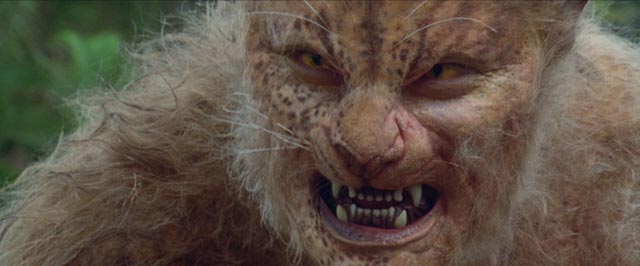
The producers had no faith in Stanley, whose previous work was that of a low-budget auteur. Both Hardware and its follow-up, Dust Devil (1992), were quirky films which didn’t fit neatly into existing genre categories – Dust Devil even more so, a fact which resulted in a very troubled distribution history. In other words, Stanley fit more comfortably in the “cult director” closet rather than the Hollywood mainstream. But New Line’s intentions for Moreau were increasingly mainstream. The more outre elements of Stanley’s script (subsequently worked over by Michael Herr and others) were deemed to be “too much” and reined in. So things were not going well even though large amounts of money were invested in pre-production, including a wide range of elaborate creature make-ups developed by the Stan Winston Studio and the construction of a large-scale set on a remote part of Australia’s northeastern shore.
The choice of location was made by Stanley and his production designer Graham “Grace” Walker (Mad Max Beyond Thunderdome and, more recently, The Walking Dead) based on creative rather than practical considerations; it was a long drive from where the production was based in the town of Cairns and the weather was really unpredictable, the latter fact resulting in a couple of disastrous initial shooting days. Those first days were enough for the guys back at New Line to fire Stanley in a quick and brutal way (they didn’t contact him directly, but instead called his agent). By this time, many involved on the shoot were on Stanley’s side, attracted by his vision of the project … and thus hostile to John Frankenheimer, the fixer who was quickly hired (as he had been earlier on both Birdman of Alcatraz and The Train when their original directors were fired). The original DoP was also dismissed, and William Fraker was brought in along with Frankenheimer’s assistant director from his previous two productions, James Sbardellati. In the documentary, Sbardellati is pretty contemptuous of what he saw as a production completely out of control, hamstrung by stupid decisions made by those who preceded his arrival (particularly the choice of location).
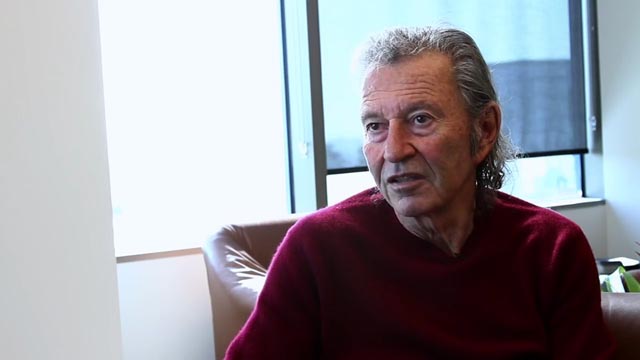
There is no doubt evidence that, as the production ballooned with New Line’s commercial ambitions, Stanley may well have been out of his depth given his relative inexperience. But when you hear Shaye say – I’m not kidding – that he realized Stanley was either crazy or incompetent because he took three or four spoons of sugar in his coffee (apparently in Shaye-world a sure sign of insanity), you realize that the company never really had any intention of allowing Stanley to make his film. They were on the look-out for any justification to remove him – and the bad weather at the start of the shoot provided the excuse.
But bringing in Frankenheimer hardly pulled things together. The production remained chaotic, with the script being rewritten day by day. It was obvious that the two stars had entered the project determined to mess with it from the start. Brando and Kilmer played egotistical star games from the beginning; while Stanley was completely ill-equipped to deal with them, it turned out that Frankenheimer was no more able to rein them in. By all accounts, the whole thing was a nightmare, particularly for those who felt some loyalty towards Stanley. Fairuza Balk, who played Aissa the cat woman, is particularly passionate about this, and still obviously bitter about being forced to stay on after Stanley’s dismissal. While the original Edward Douglas, Rob Morrow, bailed quickly, Balk was told that if she quit she’d “never be allowed to work in this town again”, the reason given being that the company had already invested a lot of money in casting her head and body and constructing the make-up appliances for her transformation back into a cat – effects which ultimately were never used. Balk says that initially Frankenheimer persuaded her that things would work out well in a collaborative atmosphere, but within days he became abusive and it was apparent that he disliked her.
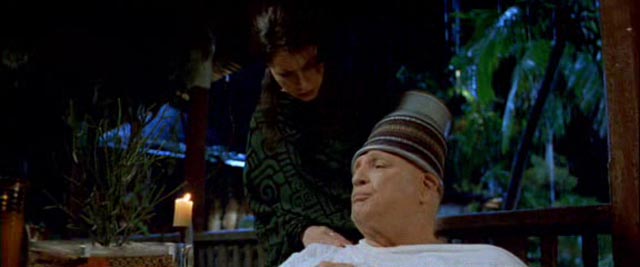
A friend of mine who works in the business once got to work with one of the actors from Moreau who told him that Frankenheimer was one of the biggest assholes he ever met, an unpleasant, abusive director who ran a very negative set. That’s an opinion seemingly shared by many of the people involved, responsible at least in part for the belief of many members of cast and crew that Moreau is a terrible film. Frankenheimer himself apparently had little interest in the project and basically took the job for the money, giving every indication that he didn’t care what was going on, allowing things to change day to day, letting his stars make stuff up. Many actors who had originally had substantial parts in Stanley’s script, although kept on, found themselves all but cut out of the film (in the case of Marco Hofschneider, who played M’Ling, the dog boy, because Kilmer thought the young German actor was taking too much attention away from himself). Key bits of action were given to whoever felt like doing them on the day. Given all this, I can only credit what I see as the film’s coherence as social satire to Brando’s acting choices; the size and force of his personality somehow managed to give the movie its particular identity. Which raises questions about the very nature of what constitutes an “auteur”.
One of the saddest, yet funniest aspects of the whole debacle was what Richard Stanley did after being fired. New Line, afraid that he would try to do something to “sabotage” the production, ordered him away from the location and had someone take him to the airport to make sure that he got on a plane back to the States. But Stanley slipped away and went into hiding in the rain forest. He eventually connected with some “hippies” who, while living rough, had been recruited as extras; through them, Stanley reconnected with some of the crew and managed to return to the set concealed beneath the prosthetic mask of one of the dog-men. When hints of this got out, it was seen as yet more proof that Stanley was insane – and perhaps fed New Line’s paranoia that he was determined to sabotage the production.
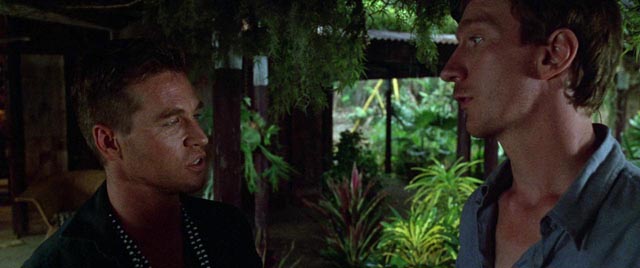
In the years since I first saw The Island of Dr. Moreau, I have become much more familiar with Richard Stanley and his work. As a person, he seems too eccentric ever to fit into the industry mould and (as in the case of Alejandro Jodorowsky’s aborted Dune) I’m not sure whether his vision of Moreau was ever actually realizable. The terrible experience he had on this project may well be the reason he has never made another feature. But it didn’t entirely destroy him as a filmmaker; he has subsequently made several shorts and contributed to two omnibus features, work which lacks the scale of Moreau, but indicates that his sensibility is more that of an independent artist than a commercial director.
But his finest work – and this includes the two early features – is the (unsurprisingly) quirky feature-length documentary The Secret Glory (2001); this film, rooted in Stanley’s adopted home in Montsegur, France (the last refuge of the Cathars before they were wiped out by the Church in the Albigensian Crusade), and his long-standing interest in the occult, deals with SS Obersturmfuhrer Otto Rahn, who went in search of the Holy Grail for the Nazis (he was a key model for the bad guys in Raiders of the Lost Ark). Unconventional, discursive, elliptical, The Secret Glory seems to be an almost perfect reflection of Stanley’s personality; it was really this film which turned me into a dedicated fan. Which is why I feel ambivalent (and perhaps a little guilty) for still loving The Island of Dr. Moreau, which stands as a monument to the crushing of his creative spirit at the hands of Hollywood businessmen who couldn’t care less about his idiosyncratic vision.
The good news, of course, is that we can now at least glimpse the outlines of that vision in David Gregory’s documentary; the even better news is that Severin Films have released the documentary in a richly supplemented three-disk set which includes almost four hours of extra material, as well as a CD of Stanley reading the complete H.G. Wells novel.
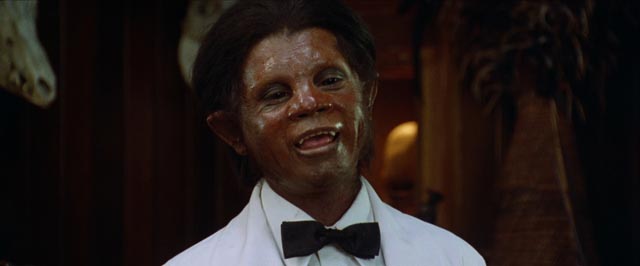
The extras include additional interview material from Stanley (47:36); Marco Hofschneider (the dog-boy M’Ling, 16:33); Jim Sbardellati (5:45); Graham “Grace” Walker (2:18); Graham Humphreys (production illustrator, 1:17); and Hugh & Ollie (a pair of production assistants, 1:19). Stanley narrates a gallery of Humphreys’ designs (14:32). There’s an audio interview with Barbara Steele, who has affectionate memories of working briefly with Stanley shooting some material (as Moreau’s wife) which would have been played back on the island at some point during the story; a short featurette on Stanley’s appearance in full beast-man make-up for a screening of Lost Soul at the Morbido film festival in Mexico (9:43); another featurette in quest of the original location, now completely overgrown in the Australian wilderness (6:18); and yet another with actor Neil Young, who played the Boar Man, in which he reads extracts from the diary he kept during the production – in which Frankenheimer doesn’t come off looking too good (15:15).
Speaking of Frankenheimer, there’s an archival press interview recorded during the movie’s initial release (6:02). Given what we’ve learned since about the production, he comes across as a bald-faced liar as he does what he’s paid to do: say nice things about everyone involved and assure the audience that it’s a great movie. Seen through the filter of the now well-known history of the production, it seems apparent that Frankenheimer can barely summon the energy here to go through the motions, sticking to a script without conviction as he denies having any problems with Brando or Kilmer (whom he famously said was one of the worst people he’d ever worked with and that he needed psychiatric help).
All of this is included on the set’s first disk. The second disk has a featurette about film adaptations of Wells’ work with Sylvia Hardy, an expert on the author (18:59), in which she actually has some praise for the 1996 version of Moreau; a featurette with Stanley talking about his own relationship with Wells’ work and its larger implications (16:09); and finally an unofficial 1921 German silent adaptation of the book called Insel der Verschollenen (The Island of the Lost, [1:01:50]). This last isn’t very good – it concentrates on a romantic quadrangle, with the Moreau-like doctor at the periphery until the last act, when he intends to animate his human-animal hybrid with the heart of a young woman, an experiment which goes wrong when his Asian assistant brings him the heart of a tiger instead. The print is battered and incomplete, but the transfer is passable – marred chiefly by a large Severin watermark which keeps popping up over the image (a practice I despise).
*
As for the rest of Stanley’s work, he has previously been very well-treated on DVD with a fine two-disk special edition of Hardware, released by Severin in 2009, and an even better five-disk edition of Dust Devil, released by Subversive Cinema in 2006, which includes “The Final Cut”, Stanley’s preferred version, as well as the slightly longer workprint, plus the director’s three major documentaries: The Secret Glory; Voice of the Moon (1990), in which the then-23-year-old risked his life to go into the mountains of Afghanistan to film an impressionistic portrait of the mujahideen fighting against the Soviet occupation; and The White Darkness (2002), an account of modern-day voodoo practice in Haiti. Both sets come with numerous featurettes and commentary tracks, all of which are guaranteed to enhance the viewer’s respect for Stanley as a creative filmmaker. It’s still possible to find copies of these on-line.
Stanley’s almost feature-length “concept album” music video Brave (1994), a visualization of Marillion’s album of the same name about a young woman’s existential crisis in a meaningless world, is out of print but can also still be found (for highly inflated prices) on-line. The big attraction of this DVD is a half-hour making-of in which fans can get another dose of Richard Stanley’s engagingly eccentric personality.
Comments
I agree that Moreau is an excellent film
Better than anyone has ever given it credit for
The doc on Stanley was surprising because I found myself agreeing with the producers n production people
And sympathizing with their plight as well.
Working in the industry myself I have seen these situations happen w stars out of control and directors out of their depth and clueless producers hoping beyond all rational point that their movie will be made
Everyone on the production staff had a real duck n cover approach to the situation until it was too late etc
Stanley comes across as he always has to me as a lovable pretentious goof artist
I love all his movies
Especially dust devil and secret glory
So it was a pleasure to watch this doc a couple of times and then watch Moreau again
Every thrill that I received when I first saw it was revisited again n again
And still love it
It was the best unintentional cult art film I had seen in a long time
It’s rare that a good movie gets made in the corporate structure of contemporary film making
So when the chaos of egos, stars’ insecurity n greed come together to make an unintentional excellent movie
it gives me hope.
I think it’s time to put this messed up team of egos and incompetents to work on an avengers sequel
Although I think calling Stanley a “lovable pretentious goof artist” is a bit extreme, I will admit that my liking for his films has a lot to do with his personality. I just listened again to the commentary tracks for Hardware, Dust Devil, Secret Glory, Voice of the Moon and White Darkness and was totally engaged by his enthusiasm; he is passionate about his work and very articulate about the ideas behind it all. Maybe his attention to aesthetics and symbolism, history, religion and philosophy seems pretentious because we no longer trust the intellectual dimension of creativity. Stanley just seems like an authentic artist, someone who doesn’t approach his work in a calculated way … and that means that he really doesn’t fit into the commercial mould demanded by the mainstream. (I also really enjoyed his reading of the Wells novel, which he gets into with the same passion and commitment.)
Might your political stance be over whelming at times, e.g. regarding Dear Margaret?
An observation I like (which should annoy you). The Far Left and Far Right have one thing in common…they don’t change.
It’s true that I have always, and still do, tend towards the left, but I don’t think that invalidates the observation that Thatcherism and Reaganism have done appalling damage to the very idea of society as a shared thing, rather than an illusion concealing the “reality” that we are all singular individuals whose personal interests supersede the communal interests of our species. Neo-liberalism and what now passes for “conservatism” have wreaked havoc all over the world, which is not to say that left-wing extremism hasn’t also caused great harm. Human beings seem to tend towards extremes of self-interest (social, political, economic and religious). I just happen to live in a place where rightist neo-liberalism has done the most damage to my own society, so I tend to see that most clearly.